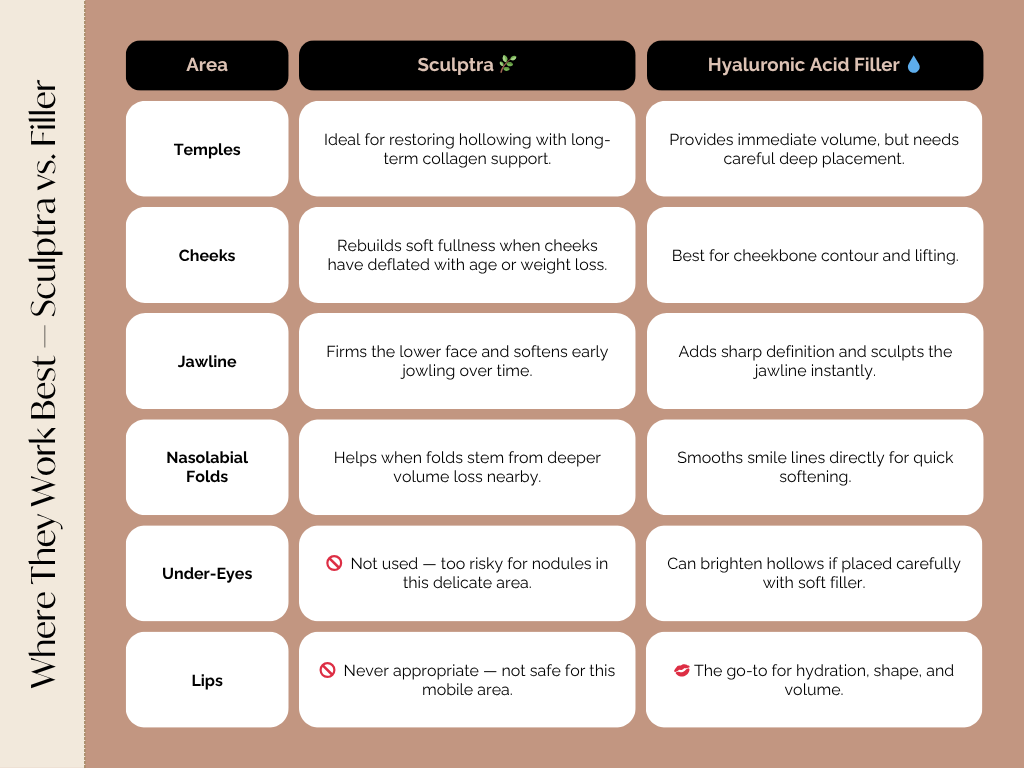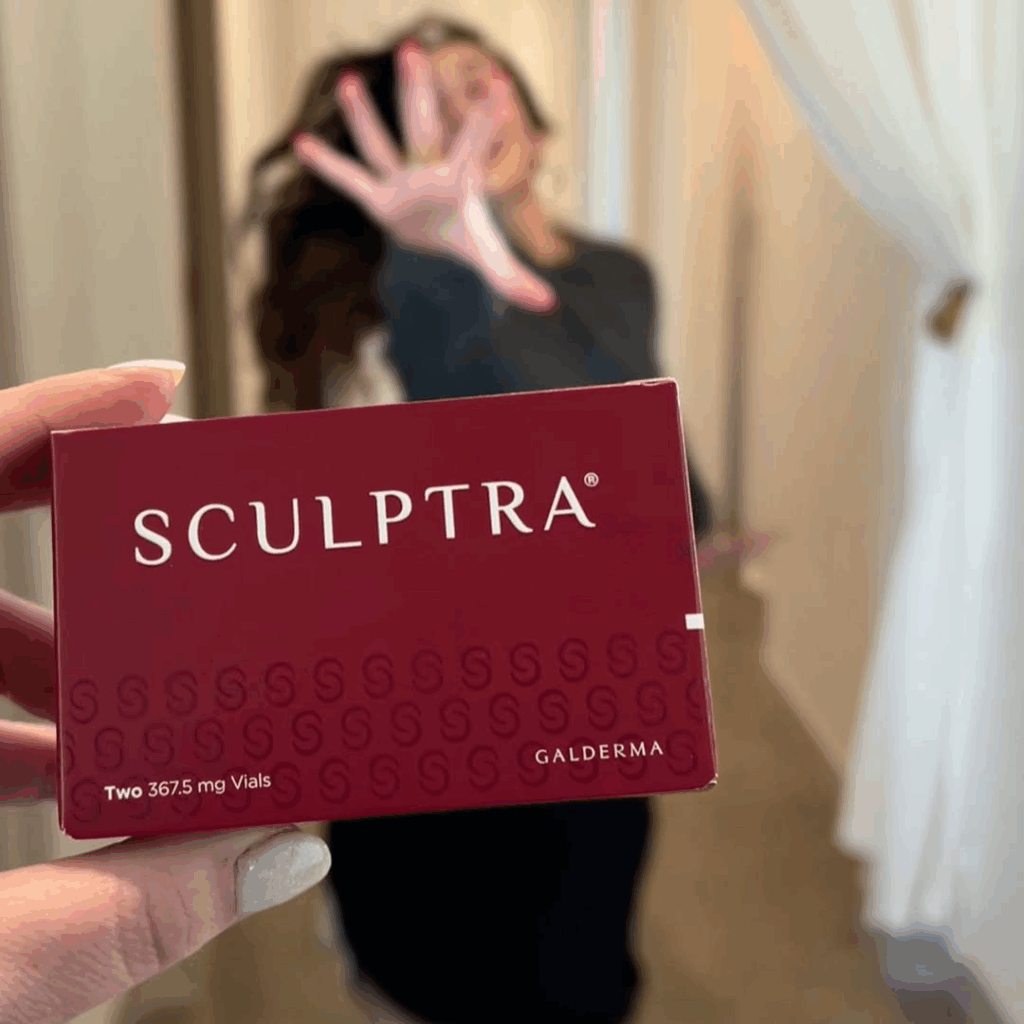Filler or Sculptra? How to Choose the Right Injectable for You
When people hear “filler,” they usually think instant plump. A quick treatment, a little volume, and voilà — cheeks lifted, lips softened, hollows filled.
But not all fillers work the same way.
There’s a whole category of injectables that doesn’t just replace volume — it helps your skin rebuild it. One of the most popular (and most misunderstood) is Sculptra.
We get questions about it all the time. How is it different from regular filler? Is it better? Does it last longer? Will I still look natural?
If you’ve been wondering the same, this guide is for you. We’ll break down exactly how Sculptra compares to traditional dermal filler, what each is designed to do, and how to decide which one is right for your face, your skin, and your goals.
What Are Fillers, Really? A Quick Breakdown
Let’s start with what most people mean when they say “filler.”
In most cases, they’re talking about hyaluronic acid (HA) fillers — clear, gel-like substances injected beneath the skin to restore volume, shape features, or smooth out lines and hollows.
HA is a sugar molecule your body naturally produces. It attracts and holds water, which is why HA-based fillers create such hydrated, plump, youthful results. When injected, they provide volume exactly where it’s needed, and the effect is instant.

At The Luxe Room, we use a variety of best-in-class fillers and injectables, including Juvederm, Voluma, Restylane, Restylane Kysse, Sculptra, and Kybella. HA fillers vary in texture and density — some are soft and flexible for delicate areas like the lips or under-eyes, while others offer structure and lift for the cheeks, chin, or jawline.
Common uses include:
- Restoring midface volume
- Sculpting the chin and jawline
- Enhancing lips
- Brightening tired under-eyes
- Softening smile lines
They’re safe, customizable, and reversible — a winning combination.
(That said, no treatment is perfect. We’ll cover the good, the bad, and the bloated in a bit.)
What Is Sculptra — And Why Is It Different?
While hyaluronic acid fillers add volume by filling space beneath the skin, Sculptra works in an entirely different way.
It’s what we call a biostimulatory filler, meaning it doesn’t just plump the skin temporarily. Instead, it stimulates your body to rebuild what’s been lost by encouraging new collagen production in the treated areas.
The active ingredient is poly-L-lactic acid — the same material used in many dissolvable surgical sutures. Years ago, doctors noticed that these sutures triggered localized scar tissue (mostly made of collagen), which led to the development of Sculptra as an injectable. It was first FDA-approved in 2004 for volume loss in HIV patients, and more recently for treating wrinkles and facial aging in the general population.
Once injected, Sculptra activates your fibroblasts (the cells that make collagen), and gets them working again. But it doesn’t happen overnight. Most clients begin to see visible changes after 6 to 12 weeks, and the best results come from a series of three treatments, spaced a few weeks apart.
The transformation is subtle and progressive. Smoother skin, improved tone, and a refreshed, lifted look people often describe as the “Sculptra glow.”
How They Work: Gel vs. Collagen Stimulation
Although both dermal fillers and Sculptra fall under the injectable category, they work through entirely different mechanisms, and understanding those differences is key to choosing the right treatment plan.
Hyaluronic acid (HA) fillers provide immediate volumization by physically occupying space beneath the skin. The gel adds structure and support where volume has been lost, typically in the midface, lips, jawline, or tear troughs. The result is visible as soon as the product is injected, and with the right technique, it can enhance symmetry, contour, and definition with precision.
Sculptra, on the other hand, is not a volumizer in the traditional sense. It’s a biostimulatory injectable. Rather than filling, it stimulates fibroblasts to produce new collagen, gradually rebuilding the skin’s structural matrix over time. The active ingredient, poly-L-lactic acid, triggers a controlled inflammatory response that encourages your body to repair and regenerate lost support tissue.
The results unfold subtly over weeks, and because the volume comes from your own collagen, the end result tends to look and feel more integrated. Less like product, more like you.
Where Each Product Belongs — And Why It Matters
One of the biggest mistakes we see is thinking any filler can go anywhere. The truth is, different products are designed for different goals — and not every area of the face responds the same way. Sculptra and HA filler each have their strengths, but knowing where to use them (and where not to) makes all the difference.
Here’s a quick breakdown of where we typically use each injectable — and where we don’t.

What to Expect During Treatment
While both dermal filler and Sculptra are injectable treatments, the experience and post-care are different in a few key ways.
So what can you expect when you come in?
Filler appointments are pretty straightforward. You’ll chat with your injector about your goals, we’ll assess your facial structure, and then we get to work. Most HA filler treatments take under an hour, and the results are visible right away. You might have some swelling or bruising for a few days, especially around the lips or under-eyes, but there’s no downtime.
Sculptra is a slower process. You won’t walk out of your first appointment looking noticeably different, and that’s the point. It’s all about building collagen gradually. Most clients need a series of three sessions, spaced a few weeks apart, to get the full effect.
And yes, there’s homework. After each appointment, we’ll walk you through the 5-5-5 massage rule: five minutes, five times a day, for five days. It helps the product spread evenly and minimizes the chance of side effects like nodules.
How Long Do Results Last & Is Treatment Reversible?
Let’s talk about longevity, because injectables don’t all age the same.
Hyaluronic acid fillers typically last between 6 and 12 months, depending on where they’re placed, the product used, and how fast your body metabolizes it. Areas with a lot of movement, like the lips, may fade sooner, while filler in the cheeks often holds up longer. To maintain results, you’ll likely need a refresh once or twice a year.
The upside? It’s flexible. If something feels off — maybe it’s too much volume, or it just doesn’t sit quite right — HA filler can be dissolved with an enzyme called hyaluronidase. This gives patients (especially first-timers) peace of mind knowing it’s not a forever decision.
Sculptra, on the other hand, is more of a long game. The product itself dissolves gradually over 9 to 24 months, but the collagen your body creates in response can last two years or more. That’s why it’s often considered semi-permanent.
But it also comes with less flexibility. Once your body builds collagen, you can’t un-build it. Sculptra can’t be dissolved like HA filler, and in rare cases where too much collagen develops in one spot — or a small nodule forms — correction can be tricky. That’s why injector technique and conservative dosing are key. When used thoughtfully, Sculptra delivers incredibly natural, long-lasting results with very little upkeep.

Sculptra or Filler? Here’s How to Decide
It’s not about which injectable is better — it’s about what’s better for you.
If you want sculpting, instant gratification, or feature enhancement (like sharper cheeks or a more defined jawline), HA filler is probably the better fit. It’s flexible, customizable, and reversible — all of which make it ideal for precision work or first-time clients.
If you’re noticing volume loss, skin thinning, or an overall “tired” look, and you’re okay with playing the long game, Sculptra might be your perfect match. It doesn’t change the shape of your face, but rather it restores what used to be there. And when done well, the results don’t look like filler. They just look like you, a little fresher and a little firmer.
Let’s Build Your Plan
Whether you’re considering Sculptra, filler, or a combination of both, the most important thing is that your treatment reflects you—your face, your goals, your pace. We’re not here to rush or overdo anything. We’re here to build something that looks good now and still makes sense years from now.
Every face ages in its own way. Your treatment should too.
If you’re ready to explore what subtle, strategic rejuvenation could look like, we’d love to meet you. Book a consultation and let’s create a plan that keeps you looking young and rested.



